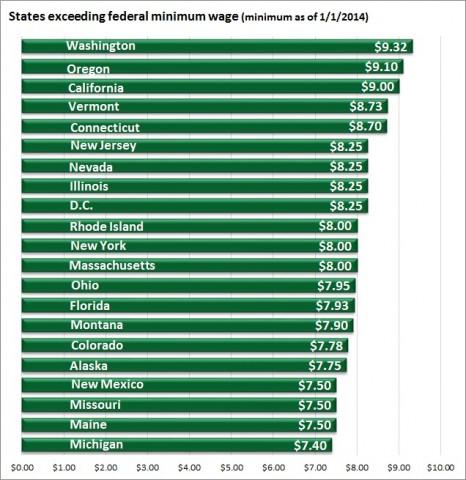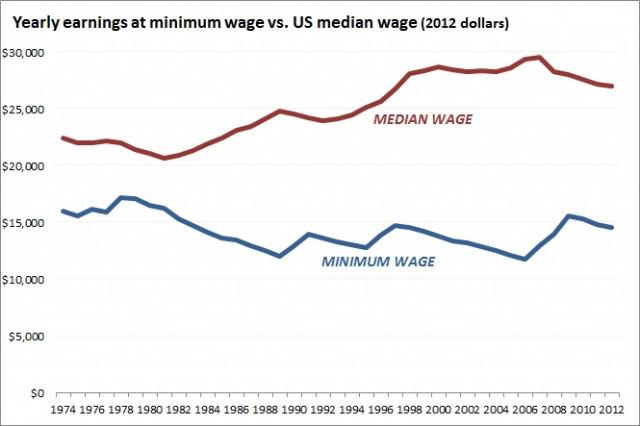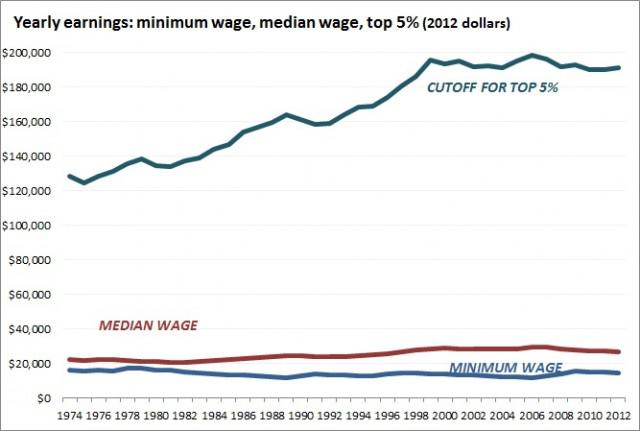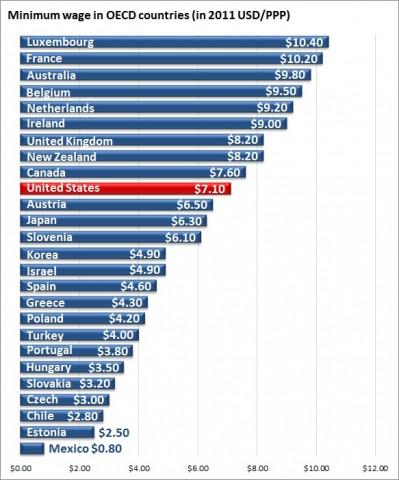After a long period in which few people outside liberal circles talked about increasing the federal minimum wage from its current level of $7.25 an hour, the issue is now in the headlines almost every day. Fast food workers will be striking in 130 cities around the country to demand a higher minimum wage on Thursday. The Washington, DC city council just voted unanimously to increase the city's minimum wage in stages to $11.50. Just over the DC border, the Maryland suburban counties of Montgomery and Prince George's voted to raise their minimums to $11.50 as well. Voters in SeaTac, WA passed an initiative raising their minimum to $15. The California legislature voted in September to raise the state's minimum to $10. Voters in New Jersey and legislators in New York, Connecticut, and Rhode Island have all passed increases this year. More states are sure to follow in 2014.
This is an issue with both economic and political implications; Democrats are hoping to use minimum wage referenda to support their candidates in 2014, including vulnerable senators in the South. They'll likely meet with success, since around three-quarters of the public supports an increase. So what facts about the minimum wage do we need to keep in mind to understand the debate?
First, this new movement is gaining strength for a number of reasons. The economy's continued sluggishness and worsening economic inequality are obvious explanations, but just as important is that the value of the minimum wage declines every year it stays at the same rate. The last increase took effect almost five years ago, and while that isn't the longest stretch we've had-the minimum was at $5.15 for ten years starting in 1998, and at $3.35 for nine years in the 1980s-minimum wage workers increasingly find it impossible to live on what works out to be a yearly salary of $14,500 (if you assume full-time hours for 50 weeks a year). At that income you'll technically be above the poverty level for a single person, but not for anyone with children. And despite the widespread belief that minimum wage workers are just teenagers working afterschool jobs, according to the Bureau of Labor Statistics, in 2012 there were 2.7 million Americans age 20 or above earning minimum wage or less (the ones who earn less mostly work for tips and are allowed to be paid a sub-minimum wage). Millions more who earn just above minimum wage would be in line for a raise if the minimum were raised.

Second, the minimum wage is different in different parts of the country. There are 20 states, plus the District of Columbia, that have minimum wages that exceed the federal $7.25. A few include yearly increases pegged to the cost of living, which has become part of most proposals to raise the federal minimum. Nearly all of the states with higher minimums-particularly those where the state minimum exceeds the federal minimum by more than a few cents-are states that have been governed in recent years by Democrats.

Third, as bad as wage stagnation has been for most Americans in recent decades, it has been even worse for those earning minimum wage. In 1980, the median wage for an American worker was around $8,000, or about $21,000 today. A minimum wage worker at the time made $6,200 a year, or three-quarters of what the median worker made. In 2012, the median wage was $26,989. The minimum wage worker's $14,500 yearly take is just over half that (figures come from the census)

And if we compare both groups to people nearer the top, we see just how bad things are. This group shows minimum and median wages compared to those at the cutoff for the top 5 percent of income earners. Keep in mind that the incomes of the top 1 percent increased at an even faster rate over this period, and those of the top .1 percent even faster than that. In 1980, a minimum wage worker made 12 percent of what someone breaking into the top 5 percent of earners made. In 2012, they made less than 8 percent.

How do we compare to other developed countries? The Organisation for Economic Cooperation and Development gathers data on minimum wages, and theirs show-at first glance-that we're in the middle of the pack, lower than most Western European countries, but higher than most Eastern and Southern European countries. 11 These OECD data use real wages with 2011 as the base year, then utilize a Purchasing Power Parity calculation which smoothes out variations caused by fluctuating exchange rates. The U.S. data are from 2012, which is why the 2011 base year produces an adjusted U.S. minimum of $7.10 instead of its actual $7.25.

That's not a particularly encouraging picture, but it's even worse when you consider that most of the countries on that list have far more generous social welfare policies than we do. A minimum wage worker in a place like France or the Netherlands will also benefit from free or low-cost health insurance, child care, and education, and will also get paid vacations, something almost no minimum wage worker in America can ever even dream of.



